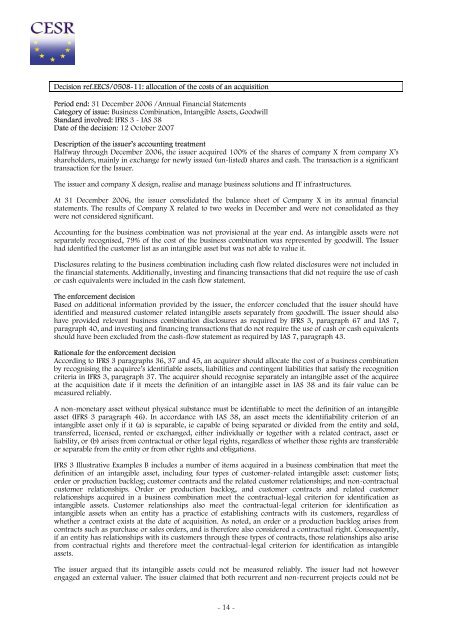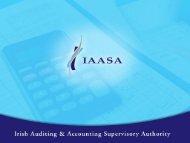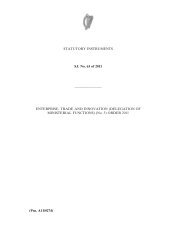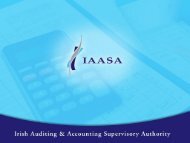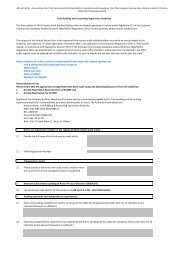View - Esma
View - Esma
View - Esma
Create successful ePaper yourself
Turn your PDF publications into a flip-book with our unique Google optimized e-Paper software.
Decision ref.EECS/0508-11: allocation of the costs of an acquisitionPeriod end: 31 December 2006 /Annual Financial StatementsCategory of issue: Business Combination, Intangible Assets, GoodwillStandard involved: IFRS 3 - IAS 38Date of the decision: 12 October 2007Description of the issuer’s accounting treatmentHalfway through December 2006, the issuer acquired 100% of the shares of company X from company X’sshareholders, mainly in exchange for newly issued (un-listed) shares and cash. The transaction is a significanttransaction for the Issuer.The issuer and company X design, realise and manage business solutions and IT infrastructures.At 31 December 2006, the issuer consolidated the balance sheet of Company X in its annual financialstatements. The results of Company X related to two weeks in December and were not consolidated as theywere not considered significant.Accounting for the business combination was not provisional at the year end. As intangible assets were notseparately recognised, 79% of the cost of the business combination was represented by goodwill. The Issuerhad identified the customer list as an intangible asset but was not able to value it.Disclosures relating to the business combination including cash flow related disclosures were not included inthe financial statements. Additionally, investing and financing transactions that did not require the use of cashor cash equivalents were included in the cash flow statement.The enforcement decisionBased on additional information provided by the issuer, the enforcer concluded that the issuer should haveidentified and measured customer related intangible assets separately from goodwill. The issuer should alsohave provided relevant business combination disclosures as required by IFRS 3, paragraph 67 and IAS 7,paragraph 40, and investing and financing transactions that do not require the use of cash or cash equivalentsshould have been excluded from the cash-flow statement as required by IAS 7, paragraph 43.Rationale for the enforcement decisionAccording to IFRS 3 paragraphs 36, 37 and 45, an acquirer should allocate the cost of a business combinationby recognising the acquiree’s identifiable assets, liabilities and contingent liabilities that satisfy the recognitioncriteria in IFRS 3, paragraph 37. The acquirer should recognise separately an intangible asset of the acquireeat the acquisition date if it meets the definition of an intangible asset in IAS 38 and its fair value can bemeasured reliably.A non-monetary asset without physical substance must be identifiable to meet the definition of an intangibleasset (IFRS 3 paragraph 46). In accordance with IAS 38, an asset meets the identifiability criterion of anintangible asset only if it (a) is separable, ie capable of being separated or divided from the entity and sold,transferred, licensed, rented or exchanged, either individually or together with a related contract, asset orliability, or (b) arises from contractual or other legal rights, regardless of whether those rights are transferableor separable from the entity or from other rights and obligations.IFRS 3 Illustrative Examples B includes a number of items acquired in a business combination that meet thedefinition of an intangible asset, including four types of customer-related intangible asset: customer lists;order or production backlog; customer contracts and the related customer relationships; and non-contractualcustomer relationships. Order or production backlog, and customer contracts and related customerrelationships acquired in a business combination meet the contractual-legal criterion for identification asintangible assets. Customer relationships also meet the contractual-legal criterion for identification asintangible assets when an entity has a practice of establishing contracts with its customers, regardless ofwhether a contract exists at the date of acquisition. As noted, an order or a production backlog arises fromcontracts such as purchase or sales orders, and is therefore also considered a contractual right. Consequently,if an entity has relationships with its customers through these types of contracts, those relationships also arisefrom contractual rights and therefore meet the contractual-legal criterion for identification as intangibleassets.The issuer argued that its intangible assets could not be measured reliably. The issuer had not howeverengaged an external valuer. The issuer claimed that both recurrent and non-recurrent projects could not be- 14 -


